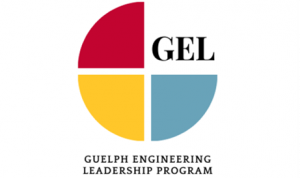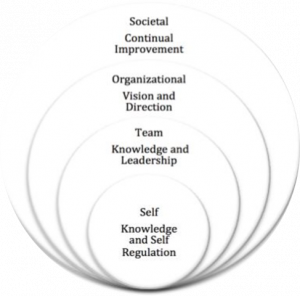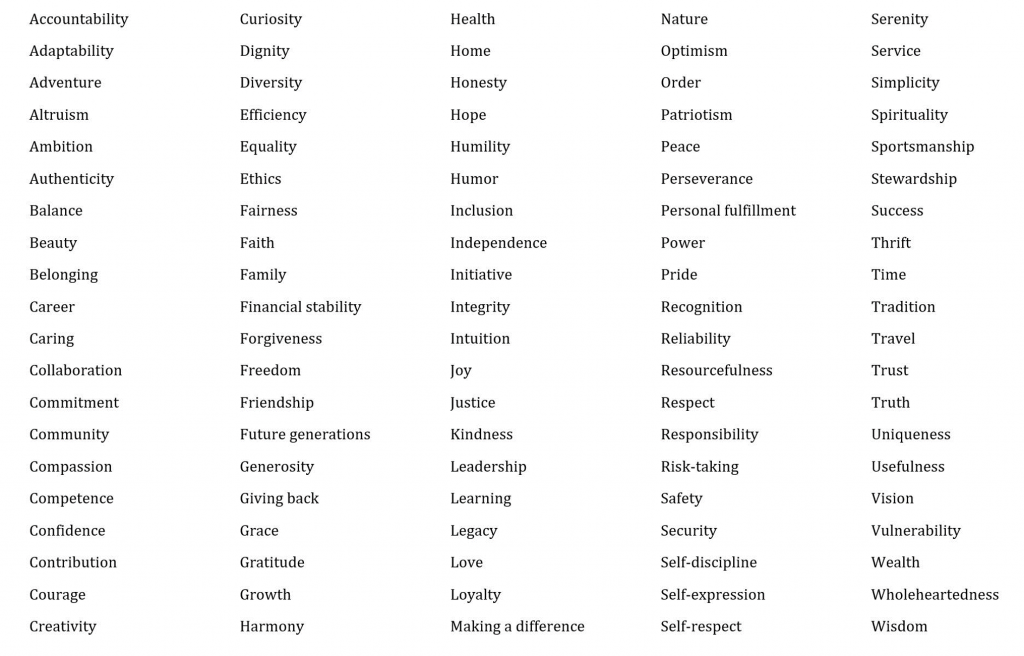Workshop 4: What is Engineering Leadership?
Meryl Britto; John Donald; and Technical Editor: Faith Miller-Koren

LEARNING OBJECTIVES
As part of the GEL program, these workshops are designed for engineering students to develop personal and professional leadership skills, and to see leadership as an integral part of their engineering identity. In this workshop, we will be branching out into leadership domain 2 and 3, team and organizational leadership.
Following this workshop, students will be able to:
- Reflect on their personal leadership style.
- Identify the qualities of a 21st century engineer.
- Analyze their engineering leadership capabilities.

Jamieson, M., & Donald, J. (2020). Building the Engineering Mindset: Developing Leadership and Management Competencies in the Engineering Curriculum.
This workshop will be split into three main parts:
- Personal Leadership
- Engineering Leadership
- The 21st Century Engineer
WHAT ARE VALUES?
In Workshop 1: Self Awareness & Self Leadership, students learned about the importance of values. Let us look back for a moment and see what a value really is.
“A value is a way of being or believing that we hold most important… Living into our values means we do more than profess them, we practice them.”
Brown, B. (2018). Dare to Lead: Brave Work. Tough Conversations. Whole Hearts. Ebury Publishing. https://books.google.ca/books?id=TjQAtwEACAAJ
Values are important in your everyday life, and most likely when making an important decision, you fall back onto your values. They are also important in leadership because knowing your values, being able to talk about them, and trying to understand other people’s values makes you a better team player.
REFELCTING ON YOUR PERSONAL VALUES
Before beginning the rest of the workshop, pick 2-3 values from the list below that resonate with and are important to you. Write these values down on a piece of paper and keep them in mind as we go through this workshop activities and learn about engineering leadership.

Brown, B. (2018). Dare to Lead: Brave Work. Tough Conversations. Whole Hearts. Ebury Publishing. https://books.google.ca/books?id=TjQAtwEACAAJ
PERSONAL LEADERSHIP
ACTIVITY 1: LEADERSHIP STYLE SURVEY
The first activity in this workshop is found in the book “The Platinum Rule” by Tony Alessandra and Michael O’Connor. In this activity, they ask you to complete an 18 question survey, to help determine your personal style of leadership. You can use the worksheet here to complete this sourced activity.
More information on this survey activity and the leadership styles can be found in the book.
 Alessandra, A. J., & O’Connor, M. J. (1998). The platinum rule: Discover the four basic business personalities–and how they can lead you to Success. Grand Central Publishing.
Alessandra, A. J., & O’Connor, M. J. (1998). The platinum rule: Discover the four basic business personalities–and how they can lead you to Success. Grand Central Publishing.
ACTIVITY 1: KEY TAKEAWAYS
This activity aimed to show you that you do not only belong to one style of leadership, but may find yourself in different quadrants throughout your career. It allowed you to acknowledge which style you may work well with or not, and understand the advantages and disadvantages of your style.
ENGINEERING LEADERSHIP
Leadership alone is a difficult world to define, let alone the term “engineering leadership”.
Before beginning this section of the workshop, take a moment to reflect on the following question:
As an engineering student, what qualities would you use to describe an engineering leader?
Some of the following answers were given by other engineering students:
- Someone who makes teams more effective
- Someone who focuses on ethics
- Leading by example
- Good communicator
- Organized
- Someone who knows the end goal
DEFNINING ENGINEERING LEADERSHIP
In the paper, “What is Engineering Leadership?”, Robyn Paul, Arindom Sen, and Emily Wyatt proposed two definitions of the term “engineering leadership” – one from 2002 and one from 2018. Let’s take a look at these definitions below and compare their meanings.
| 2002 |
“Engineering leadership is the process of envisioning, designing, developing, and supporting new products and services to a set of requirements, within budget, and to a schedule with acceptable levels of risk to support the strategic objectives of an organization.” |
| 2018 |
“Engineering leadership is an approach that influences others to effectively collaborate and solve problems. Engineering leadership requires technical expertise, authenticity, and personal effectiveness. Through engineering leadership, individuals and groups implement transformative change and innovation to positively influence technologies, society, and the world at large” |
Paul, R., Sen, A., & Wyatt, E. (2018). What is Engineering Leadership? A Proposed Definition. American Society for Engineering Education.
It is important to notice that there are several different definitions of engineering leadership. The 2002 definition is quite restrictive in terms of leadership, whereas the 2018 definition is a better representation of engineering leadership today, and encompasses the idea of the 21st engineer. This 2018 proposed definition provides a foundation for a clear understanding of the what, the how, the who and the why of engineering leadership.
THE 21ST CENTURY ENGINEER
Why is it important to address the topic of the 21st century engineering?
As students, we are all incoming engineers, whether or not you have had technical experience in your field. It is important to develop and acknowledge your leadership capabilities as an engineer in the 21st century.
- As technology continues to evolve, engineering education must continue to evolve too.
- While engineers remain strong in their technological skills, they are generally weak in their management and communication capabilities
Galloway, P. (2008). The 21st Century Engineer. American Society for Engineering Education.
“Everything you are taught now will most likely become irrelevant by the time you graduate”
-Anthony Fasano, Author of ”Engineer Your Own Success”
Anthony Fasano is the founder of Engineering Management Institute, a company focused on helping engineering organizations develop effective managers and powerful leaders. Today’s engineers are faced with challenges that are vastly different from the challenges faced by previous generations. These challenges include global commercial competition, intelligent technology, and a constantly changing work environment. Academic curricula does not always adjust to the new realities and there is a increasing gap between education and what is demanded in the market. Therefore, we need to be more willing and open to the idea that through our curriculum we have learned so many leadership skills – we just don’t realize it or use them.
- Why do you believe they are a successful leader?
- What are the impacts that they have on their employees and organizations?
- Out of the 4 leadership styles which one(s) do you believe this leader is?
- As a 21st century engineer, what qualities were you most attracted too?
- Which traits would I want to emulate from this leader?
ACTIVITY 2: KEY TAKEAWAYS
Different successful people in different industries, with engineering or science backgrounds, can have different leadership styles. It is important to analyze these engineering leaders and their accomplishments, to see that we can all be successful as different types of leaders.
1. Relating
- Inquiring and Dialoging –Listening to others with the intention of genuinely understanding their thoughts and feelings.
- Advocacy – The ability to clearly explain one’s own point of view or approach, advocate a position, and explain how one reached their interpretation and conclusion.
- Structured Communications – Being able to create a strategy and structure to formal communications, and present information orally.
2. Making Sense of Context
-
Identifying a vision for the solution, and setting achievable goals for performance (including quality), budget and schedule.
3. Visioning
-
Identifying a vision for the solution, and setting achievable goals for performance (including quality), budget and schedule.
ACTIVITY 3: ENGINEERING LEADERSHIP CAPABILITIES
In this activity, you will use the engineering leadership capabilities we have just learnt to reflect on your personal leadership style and general engineering leadership. If needed, go back to activity 1 to review your leadership style.
The worksheet for this activity can be found here or can be completed below. Fill out column 3 and 4 in the table.
| Leadership Capabilities | Definition | Personal Leadership
Based on your personal leadership style, list behaviours that support or oppose this capability. |
Engineering Leadership
Why is it important for you to develop this Leadership Capability to be an effective engineering leader? |
| Relating |
|
Ex. As a Relator, I find it very easy to understand peoples’ views and to compromise
|
Ex. Helps me to identify potential disagreements within my team
|
| Visioning |
|
|
|
| Making Sense of Context |
|
WORKSHOP KEY TAKEAWAYS
Developing strong ideas about leadership in engineering is the key to creating strategical and innovating engineers, who have a strong understanding of the issues confronting the 21st century engineer. In this workshop you were able to enhance personal leadership styles and hopefully takeaway the following key points:
- Recognizing that there are many types of successful leadership styles.
- Engineers have many great leadership qualities that we have learned through our curriculum, but many do not identify themselves leaders.
- Understanding and analyzing professional leadership traits will lead to greater confidence in individual’s engineering identity.
- Your leadership style can change throughout your career.
RESOURCES
Click here to access the workshop worksheets.

